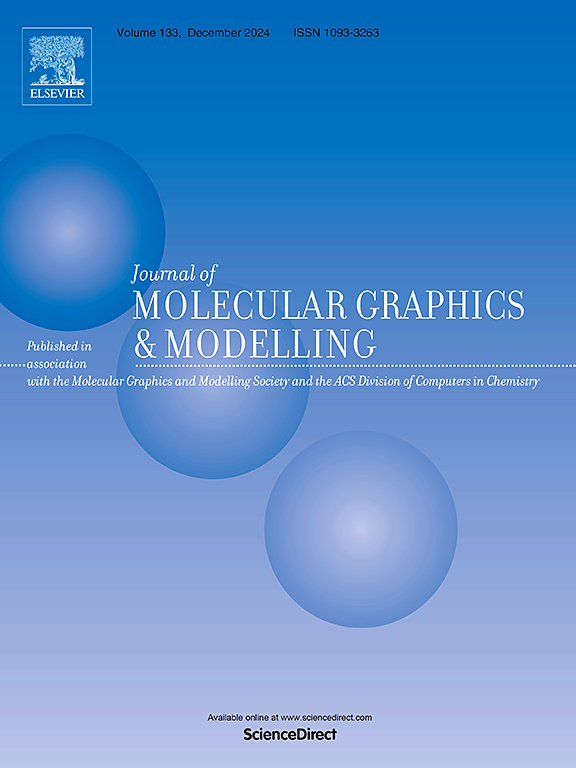Integrative in silico analysis to explore the potential of Zingiberaceae compounds to inhibit estrogen receptor alpha activity in breast cancer
IF 3
4区 生物学
Q2 BIOCHEMICAL RESEARCH METHODS
引用次数: 0
Abstract
The estrogen receptor alpha (ERα) is a critical player in breast cancer progression, making it a key target for therapeutic development. This study employed an advanced computational method to discover potential inhibitors of ERα from a library of compounds from the Zingiberaceae family. The workflow includes virtual screening, re-docking, molecular dynamics (MD) simulations, radius of gyration (RG), and root mean-square deviation (RMSD)-based free energy landscape (FEL) analysis. This multifaceted strategy led to the selection of four compounds with superior docking scores compared to established control molecules. The MD simulation assessments confirmed that these selected compounds exhibited robust stability and favorable binding interactions within the ERα binding pocket. Notably, the pocket volume analysis of the minimum energy structures obtained from FEL analysis indicated a significant reduction in volume compared to the initial docking poses, suggesting a more compact and potentially more effective binding conformation. These findings highlight the potential of Zingiberaceae family-derived compounds as promising candidates for ERα inhibition. The stability of these interactions and the observed compactness of the binding pocket, as demonstrated by our comprehensive computational analysis, underscore the potential of these compounds for further preclinical evaluation.

通过整合性硅学分析探索银杏科化合物抑制乳腺癌雌激素受体α活性的潜力
雌激素受体α (ERα)在乳腺癌进展中起着关键作用,使其成为治疗开发的关键靶点。本研究采用先进的计算方法从姜科化合物库中发现潜在的ERα抑制剂。工作流程包括虚拟筛选、再对接、分子动力学(MD)模拟、旋转半径(RG)和基于均方根偏差(RMSD)的自由能景观(FEL)分析。这种多方面的策略导致了四种化合物的选择,与已建立的对照分子相比,它们具有更高的对接分数。MD模拟评估证实,这些选定的化合物在ERα结合口袋内表现出强大的稳定性和良好的结合相互作用。值得注意的是,从FEL分析中获得的最小能量结构的口袋体积分析表明,与初始对接姿势相比,口袋体积显着减少,表明更紧凑,可能更有效的结合构象。这些发现突出了姜科衍生化合物作为抑制ERα的有希望的候选者的潜力。这些相互作用的稳定性和观察到的结合袋的紧密性,正如我们的综合计算分析所证明的那样,强调了这些化合物在进一步临床前评估方面的潜力。
本文章由计算机程序翻译,如有差异,请以英文原文为准。
求助全文
约1分钟内获得全文
求助全文
来源期刊

Journal of molecular graphics & modelling
生物-计算机:跨学科应用
CiteScore
5.50
自引率
6.90%
发文量
216
审稿时长
35 days
期刊介绍:
The Journal of Molecular Graphics and Modelling is devoted to the publication of papers on the uses of computers in theoretical investigations of molecular structure, function, interaction, and design. The scope of the journal includes all aspects of molecular modeling and computational chemistry, including, for instance, the study of molecular shape and properties, molecular simulations, protein and polymer engineering, drug design, materials design, structure-activity and structure-property relationships, database mining, and compound library design.
As a primary research journal, JMGM seeks to bring new knowledge to the attention of our readers. As such, submissions to the journal need to not only report results, but must draw conclusions and explore implications of the work presented. Authors are strongly encouraged to bear this in mind when preparing manuscripts. Routine applications of standard modelling approaches, providing only very limited new scientific insight, will not meet our criteria for publication. Reproducibility of reported calculations is an important issue. Wherever possible, we urge authors to enhance their papers with Supplementary Data, for example, in QSAR studies machine-readable versions of molecular datasets or in the development of new force-field parameters versions of the topology and force field parameter files. Routine applications of existing methods that do not lead to genuinely new insight will not be considered.
 求助内容:
求助内容: 应助结果提醒方式:
应助结果提醒方式:


